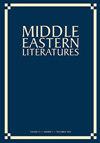Utopian/Dystopian Lebanon: constructing place in Jabbūr al-Duwayhī’s Sharīd al-manāzil
IF 0.2
4区 文学
0 LITERATURE
引用次数: 1
Abstract
ABSTRACT Sharīd al-manāzil paints a portrait of Beirut at the outbreak of the Lebanese Civil War. Born Muslim but raised by a Christian couple in the village of Ḥawra, Niẓām al-ʿAlamī embraces his mixed religious identity and seamlessly navigates Muslim and Christian religious rituals. He moves from Ḥawra to Beirut in search of adventure. When the war erupts, Niẓām is shunned by both Muslims and Christians. The seemingly utopian city is transformed into a dystopian place that demands strict sectarian affiliation and loyalty. Informed by studies of utopia and place, this essay offers a contextual analysis of the novel, focusing on three pivotal places in Niẓām’s life (and death), namely, the orchard of Niẓām’s adopted parents in Ḥawra, Niẓām’s rented apartment in Beirut, and his lover Janān’s workshop. I argue that by depicting the fluid construction of place and identity, al-Duwayhī’s novel elucidates the perils—and reversibility—of sectarianism.乌托邦/反乌托邦的黎巴嫩:在Jabbūr al- duwayh ' s sharj中构建场所al-manāzil
sharurd al-manāzil描绘了黎巴嫩内战爆发时的贝鲁特。出生的穆斯林但村里一对基督徒夫妇提出Ḥawra,倪ẓām al -阿拉姆ʿī拥抱他的宗教身份和无缝导航穆斯林和基督教的宗教仪式。他从Ḥawra搬到贝鲁特寻找冒险。当战争爆发时,穆斯林和基督徒都避开了Niẓām。这个看似乌托邦的城市变成了一个反乌托邦的地方,要求严格的宗派归属和忠诚。通过对乌托邦和地方的研究,本文对小说进行了语境分析,重点关注Niẓām生命(和死亡)中的三个关键地点,即Niẓām在Ḥawra的养父母的果园,Niẓām在贝鲁特的租来的公寓,以及他的情人Janān的工作室。我认为,通过描绘地方和身份的流动结构,al- duwayhir的小说阐明了宗派主义的危险性和可复性。
本文章由计算机程序翻译,如有差异,请以英文原文为准。
求助全文
约1分钟内获得全文
求助全文

 求助内容:
求助内容: 应助结果提醒方式:
应助结果提醒方式:


